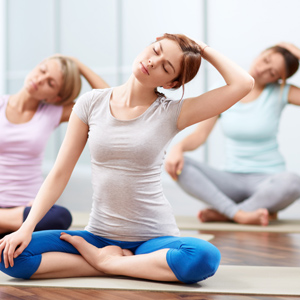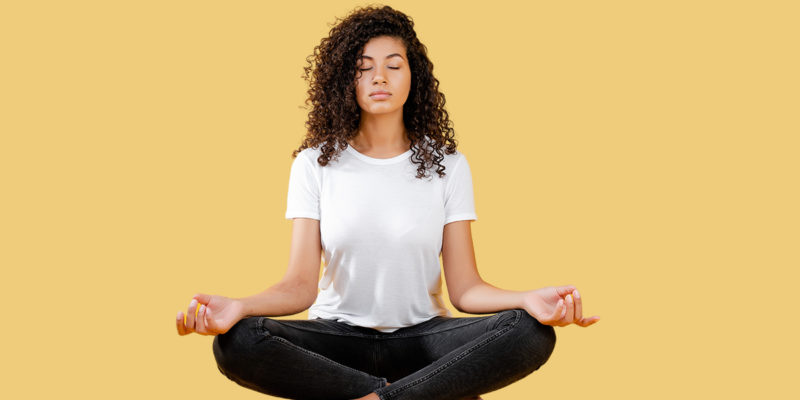Is Yoga Good for Aching Joints? These 3 Studies May Surprise You

When your joints hurt, exercise of any kind can feel like a scary task. Not only might it hurt to move your painful and stiff joints, but you also fear all that exercising may make it worse.
But one type of exercise is continually called the solution to your exercise/joint pain conundrum: yoga.

Is yoga actually good for aching joints? Is it safe? Let’s learn more and see what science has to say.
What Is Yoga?
The term yoga is actually a group name for lots of different types of practices that all include some type of breath control, meditation, and body postures. Some are extremely calming and slow moving; others feel like the most intense workout you’ve ever had. Here is just a small sample of different yoga styles:
- Hatha
- Ashtanga
- Iyengar
- Yin
- Kundalini
- Bikram
- Restorative
- Anusara
- Vinyasa (or power)
- And more!
Originating in India thousands of years ago, yoga has played a part in many eastern religions such as Hinduism and Buddhism. As it made its way to western nations, it has been used for a wide variety of reasons – from connecting spiritually and improving peace of mind to boosting fitness and health.
There are stretches and strengthening poses. Movement that gets your heart pumping and movement that helps you find total relaxation. Your joints are involved during the whole process, so let’s take a closer look at the implications.
Yoga, Joints, and Science: 3 Studies

The two big questions are:
- Will yoga improve joint pain?
- Will yoga worsen joint pain?
There have actually been quite a few studies on the impact yoga has on arthritis and joint pain, and they seem to all agree – it’s a wonderful match. Here are just three examples of how positive yoga can be for aching joints:
Yoga and Joints Study #1
In 2012, one study took two hundred and fifty people with osteoarthritis in their knees. They were randomly split into either a yoga group or a control group. The yoga group did all sorts of asanas, pranayama, yogic strengthening, yogic loosening, and even relaxation and meditation.
The control group did physiotherapy exercises.
On both day 15 and day 90, the two groups were assessed. Here are the results. Compared to the control group, the yoga group had better results, including:
- Reduced resting pain
- Decreased morning stiffness
- Reduced anxiety
- Reduced systolic and diastolic blood pressure
- Reduced pulse rate
The researchers concluded that the “integrated approach of yoga therapy is better than physiotherapy exercises” when it came to these measures.
Yoga and Joints Study #2
In 2014, a study looked at 30 women with knee osteoarthritis. They separated them – half into a yoga group (for a total of 15) and the other half in a control group. The yoga group had 3 hour-long sessions of hatha yoga each week for 8 weeks.

The researchers used questionnaires to determine their pain, symptoms, daily activities, sports, spare-time activities, and quality of life. Their findings discovered the yoga group had less pain, fewer osteoarthritis symptoms, and improved daily activities, spare-time activity, and quality of life.
Yoga and Joints Study #3
In 2015, another study looked at 75 sedentary adults – almost all female – with rheumatoid arthritis or osteoarthritis of the knee. They went through an 8-week regimen of yoga, which included two-hour-long classes and one at-home practice weekly.
At the end of the 8 weeks, their walking capacity was much better, as was their physical component summary. Other significant improvements included pain, general health, and mental health.
What’s even more amazing is the researchers followed up at 9 months and discovered there were still positive long-term effects after the study. They concluded that “yoga may help sedentary individuals with arthritis safely increase physical activity, and improve physical and psychological health.”
3 Ways Yoga Is Good for Aching Joints

So what does this all mean for you? There are three main reasons you should be starting a yoga practice if you have aching joints:
1. Yoga Makes Your Symptoms Better
This one is short and sweet. As we’ve seen in the studies above, yoga improves joint pain, joint stiffness, lack of mobility, etc. This means it’s a non-prescription way to find relief.
2. Yoga Allows You to Exercise
Movement is so incredibly important to ensure you are healthy in every single way. It is also important for the health of your joints. Yet when you struggle with arthritis or aching joints, it can be really hard to find an exercise that doesn’t make it worse.
Due to that fact, many people end up leading sedentary lives. Their joint pain gets worse. Their hearts, lungs, brains, immune systems etc. get worse. Their muscles atrophy and can no longer support the joints. Weight gain gets more extreme, and you put more pressure on your joints. It’s a terrible catch-22.
The positive impact yoga has on your aching joints allows you to have a mode of exercise you can practice for the rest of your life. It keeps you moving even through joint pain.
3. Yoga Reduces Your Stress and Anxiety
Life is really stressful on its own, but when you toss in the chronic ache of your joints, it gets a lot more stressful. Many people who struggle with joint pain, especially when it’s chronic, also suffer from anxiety and depression.
Yoga can greatly help you deal with the stress that comes from arthritis or joint pain. It can help uplift your mood in general and give you a newfound sense of groundedness. And as the studies show, this isn’t just wishful thinking. It’s scientifically proven.
Remember: there is a significant mind/body connection. When your mind is at ease, your body can be more at ease. And vice versa.
How to Try Yoga for Aching Joints

So how do you get started? It’s easy.
1. Start with an Appropriate Group Class
The nice thing about a group glass is you have a certified, experienced instructor who can help you modify the poses and correct your positioning any time you do something that could harm your joints. This is especially good for beginners.
Look for a yoga studio that offers class titles like “yoga for beginners,” “gentle yoga,” “restorative yoga,” or “therapeutic yoga” to begin with. “Hatha yoga” may be a good choice as well. As you get more familiar with the poses and build strength, you can graduate to more difficult classes. Hot yoga could be something you consider as the heat helps warm you up faster, so you can move with ease.
If there is not a yoga studio near you – or if the prices are too high – you can also look at local health clubs, community centers, the YMCA, or even senior centers.
Make sure you always tell the instructor if you have an aching joint, so he/she can keep an eye on your progress and help you modify any poses.
2. Then Try Yoga at Home
Though it is really a good idea to start taking yoga with a professional who can guide you, you can eventually try to do some yoga sequences in your own home once you build up knowledge, confidence, and physical strength/agility.
You can purchase programs to follow online or on your TV, or you can try free YouTube videos. Here is a 25- minute gentle yoga sequence for beginners to get you started:
However, you may find you really like getting out of the house and doing your practice with an instructor. Home practice may be something you just do as a fill-in from time to time.
Using Yoga to Help Your Joints
The Arthritis Foundation suggests that yoga is gentle enough that almost all people can practice it daily, so find a class today.
If you want to give your new yoga practice a natural boost, combine it with some all-natural anti-inflammatory supplements like turmeric curcumin, boswellia, and vitamin D. Any time natural lifestyle choices can improve your joint pain – the better.
Namaste!
Sources:
https://www.ncbi.nlm.nih.gov/pmc/articles/PMC3276929/
https://www.ncbi.nlm.nih.gov/pmc/articles/PMC3665019/
https://www.ncbi.nlm.nih.gov/pubmed/25834206
https://www.hopkinsarthritis.org/patient-corner/disease-management/yoga-for-arthritis/





